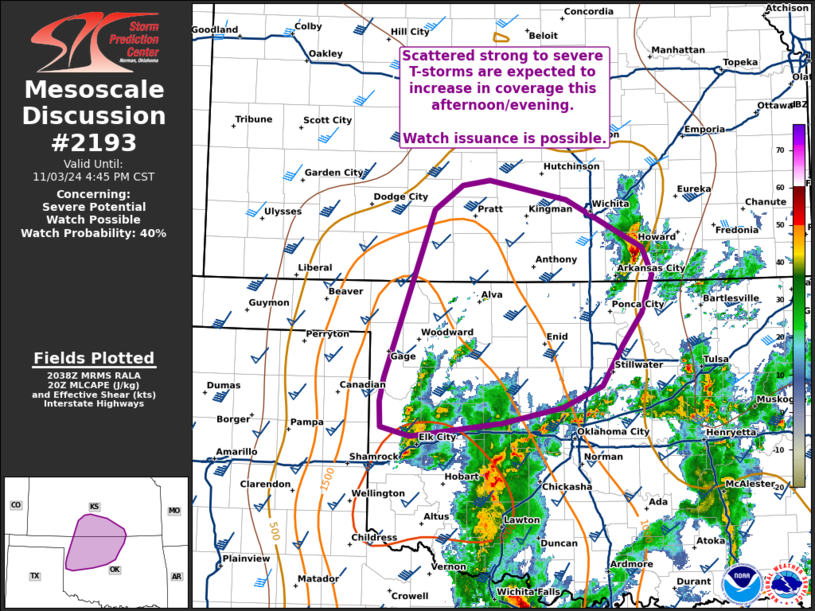|
| Mesoscale Discussion 2193 |
|
< Previous MD Next MD >
|

|
Mesoscale Discussion 2193
NWS Storm Prediction Center Norman OK
0240 PM CST Sun Nov 03 2024
Areas affected...Northwest Oklahoma into south-central Kansas
Concerning...Severe potential...Watch possible
Valid 032040Z - 032245Z
Probability of Watch Issuance...40 percent
SUMMARY...Thunderstorms will increase in coverage through the late
afternoon and evening hours. Scattered strong to severe storms are
expected and will pose a risk of large hail, damaging winds, and
perhaps a tornado. Trends will be monitored for the need for a watch
later this evening.
DISCUSSION...Over the past hour, convection has increased in
coverage across western OK along the I-40 corridor in response to
strengthening low-level warm advection and steady destabilization.
MRMS VII and cloud top temperature trends suggest that much of the
activity along and north of I-40 remains sub-severe, but signs of
intensification have been noted in a few cells. The expectation is
thunderstorm coverage will continue to increase as this activity
spreads from western OK into northwest OK and south-central KS
through the late afternoon and evening hours. While most convection
will likely remain elevated, steady warming/moistening in the low
levels may support a few surface based storms - especially where
temperatures and dewpoints can reach into the low 70s and upper 60s
respectively. 40-60 knot mid and upper-level flow over the region is
supporting elongated hodographs favorable for supercells with an
attendant risk for large hail (most likely between 1.0-1.75 inches)
and severe wind gusts. Additionally, the low-level warm advection
regime is yielding 0-1 km SRH values between 200-300 m2/s2 (per
regional VWPs), which will support a tornado threat if surface-based
convection can be realized. While this potential is noted, weak
inhibition and persistent ascent will promote scattered
thunderstorms with a somewhat high probability for storm
interactions and unfavorable storm modes as storms spread
north/northeast with time. Trends will be monitored for the need for
watch issuance if semi-discrete, surface-based convection can be
realized and pose a greater severe threat.
..Moore/Hart.. 11/03/2024
...Please see www.spc.noaa.gov for graphic product...
ATTN...WFO...TSA...ICT...OUN...DDC...
LAT...LON 35839987 36069983 37699922 37949889 37999855 37809763
37329671 37059659 36699672 36379694 35989720 35779767
35619840 35489951 35589987 35839987
|
|
Top/All Mesoscale Discussions/Forecast Products/Home
|
|



